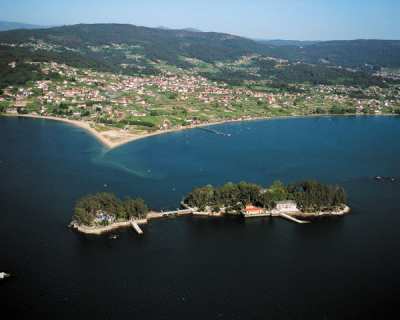The Isla de San Simón
The Isla de San Simón is one of four separate islands which make up the archipelago of the same name in the Ría of Vigo, Redondela, Galicia, which, despite its small size, has played an important role in history.
San Simón is actually two islands; it’s joined to its neighbour, San Antón, by a short bridge, making up a total length between the two of 84 metres and 250 metres wide.

Isla de San Simon - Photo www.edu.xunta.es
Its history includes Knights Templar, pirates, Spanish galleons, leprosy, incarceration and sunken treasure. The area was used as a setting in Jules Verne’s ’20,000 Leagues under the Sea’, and the Galician mediaeval poet, Mendinho, wrote of sitting in the chapel of San Simón, watching the waves, while waiting for a friend.
The island is known to have been inhabited since the 5th Century AD and has had many different stages in its history. The Knights Templar established a monastery here in the 12th Century and were followed by other religious communities over the centuries. The monastic life continued on the island until around the 18th Century, but was interrupted for a period in the late 16th Century when it was sacked during Sir Francis Drake’s attack on the Bay of Vigo and the monastery was burnt down.
The rebuilt monastery was destroyed again during the 1702 Battle of Rande or the Battle of Vigo Bay, during the War of Spanish Succession. Some of the treasure which was carried by the Spanish fleet when it was attacked is thought to still lie at the bottom of the bay. Vigo was briefly occupied by the British in 1719 and San Simón was attacked yet again, after which the monks left the island.
After almost a century of being abandoned, its next role was as a leper colony and isolation centre. The terminal patients were housed on San Antón and passengers who had travelled by ship from the Americas were kept in quarantine on San Simón before they were allowed to enter port. This had a huge impact on Vigo in establishing it as a major port on Spain’s Atlantic coast.
The next stage was during the Spanish Civil War when San Simón became a prison island for Republican prisoners opposed to General Franco. From 1948, it was used as a summer residence for members of Franco’s personal guard, but it was abandoned again after 43 of them drowned when their boat sank in 1950. Its only other use after that was between 1955 and 1963 was as a shelter and training centre for the orphans of sailors.
In 1998, work began on restoring and renovating the abandoned San Simón Islands for cultural and public use. After extensive rehabilitation, it is now a centre for cultural events, for conferences, exhibitions, education and history. San Simón was declared a BIC asset of cultural asset in 1999.
